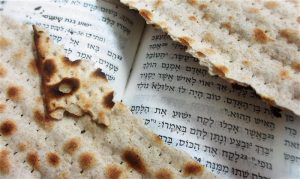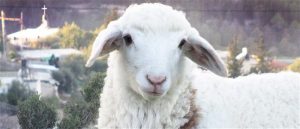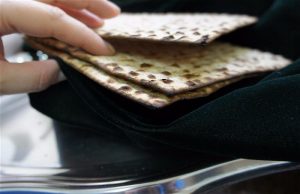Arye Polison
The Seder meal is the traditional Passover meal celebrated in all Jewish homes on the eve of Passover – marking the deliverance of the people of Israel from bondage in Egypt. This meal was also celebrated by Jesus the disciples and the early Jewish followers of Yeshua. The Hagada (Passover liturgy) used in the Jewish celebration today dates from the Middle Ages, but most likely has its roots from as far back as the second temple period. Disciples of Yeshua (Messianic Jews) today, and many churches also celebrate the Seder meal with a dual focus on the redemption from slavery in Egypt and the redemption from sin through Christ’s sacrificial death on the cross.
but most likely has its roots from as far back as the second temple period. Disciples of Yeshua (Messianic Jews) today, and many churches also celebrate the Seder meal with a dual focus on the redemption from slavery in Egypt and the redemption from sin through Christ’s sacrificial death on the cross.
“Behold the Lamb of God, who takes away the sin of the world.” (John 1:29) “God will provide for himself the lamb for the burnt offering my son.” (Gen. 22:8) ”For Messiah, our Passover lamb, has been sacrificed. Therefore let us celebrate the feast, not with old leaven, nor with the leaven of malice and wickedness, but with the unleavened bread of sincerity and truth.” (I Cor. 5:7-8)
The Jewish Passover (Pesach) was given to us to be a picture of the redemption of God’s people, and their firstborn to begin with, through the redemptive blood of His Lamb, which is to be displayed on the lintel and doorposts of our household of faith.
 The traditional Jewish Seder today is celebrated without the Lamb sacrifice, which cannot be prepared properly without the temple, at which it must be sacrificed. In the ceremony of the Passover meal, the Passover Lamb has been replaced by the Afikomen, which is the middle piece of 3 pieces of Matzah (unleavened bread) usually placed within a special compartmented cloth on its own plate on the Passover table.
The traditional Jewish Seder today is celebrated without the Lamb sacrifice, which cannot be prepared properly without the temple, at which it must be sacrificed. In the ceremony of the Passover meal, the Passover Lamb has been replaced by the Afikomen, which is the middle piece of 3 pieces of Matzah (unleavened bread) usually placed within a special compartmented cloth on its own plate on the Passover table.
In most Jewish traditional ceremonies, this Afikomen is removed and broken in two. Half is wrapped separately, and hidden somewhere in the house, for the children to search for later in the ceremony. The first half remains on the table, and a little of it is eaten symbolically during the Exodus account before the main part of the meal. When this part is symbolically eaten, it is blessed and understood to be a fulfillment of the command to eat unleavened bread during Passover. When the first and third pieces are eaten, they are blessed simply as bread for food.
After the main meal is finished, the children search for the hidden half of the Afikomen, and the one who finds it is often given a special prize. The half that was hidden and found is then broken and passed around, and eaten before midnight in place of the Passover Lamb. It is forbidden to eat of the Afikomen “Passover lamb” while hungry, so this is done after the meal is finished. This is also reflected in the words of Paul: “If anyone is hungry, let him eat at home, so that you may not come together for judgment.” (I Cor. 11:34)
For Yeshua’s disciples, this is the appropriate time to share in the Lord’s Supper. The previous use of the Afikomen in the traditional ceremony is also full of symbolism for believers in Yeshua. The three pieces of Matzah (unleavened bread) in their special cloth cover are often understood to represent the Father, Son, and Holy Spirit, as our unleavened spiritual food. The middle Matzah, representing the son, is broken as a representation of Yeshua’s body, broken for us on the cross: “This is my body, broken for you.” (I Cor. 11:24) The part partaken of before the meal represents the Lord’s Supper shared in by His disciples. The second half , hidden, represents the hiding of the Messiah from Israel during this present age. It being found by the children of the household is a picture of the Jewish remnant who will rediscover Yeshua: “Let the little children come to Me, and do not forbid them; for of such is the kingdom of heaven.” (Matt. 19:14) When it is then eaten as the Passover lamb, it is eaten also according the rules for eating the Lord’s Supper in most churches. These rules were actually derived by Paul and the disciples from the rules for eating the Passover lamb sacrifice.
, hidden, represents the hiding of the Messiah from Israel during this present age. It being found by the children of the household is a picture of the Jewish remnant who will rediscover Yeshua: “Let the little children come to Me, and do not forbid them; for of such is the kingdom of heaven.” (Matt. 19:14) When it is then eaten as the Passover lamb, it is eaten also according the rules for eating the Lord’s Supper in most churches. These rules were actually derived by Paul and the disciples from the rules for eating the Passover lamb sacrifice.
The name Afikomen is itself a mystery. A likely possibility is that it actually originated with Yeshua’s Jewish disciples, derived from the aorist tense of the Greek word for “He has come” (aphikomenos). In this way it underlines the Messianic expectations that are so clearly part of the Seder meal.
Earl (Arye) Powlison is the principle author of My Law on Your Heart: Living Yeshua’s Jewishness (Rod of Aaron, 1995). He is co-founder of the Israeli networking ministry “Restorers of Zion” (www.restorersofzion.org) which seeks to “restore the Jewish foundations of Yeshua and His disciples, in the power of the Holy Spirit, and as they were preached and practiced in the pages of the New Testament.”